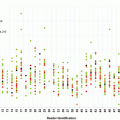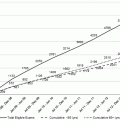Level of accountability
Name
Description
Examples of GI measures in program
Health system
Medicare Shared Savings Program
Measures ACO care coordination
CG-CAHPS
Medicare Advantage 5 Star Quality Rating System
Health plan quality incentive program
Rate of CRC screening among plan members
Medicaid Adult Core Measure Set
Basic quality metrics for Medicaid patients
Flu shots, BMI, CG-CAHPS, monitoring of persistent medications
Quality Rating System for Qualified Health Plans for Insurance Exchanges
Monitors health plans for meeting ACA standards
CAHPS, Access to specialists, cultural competency, CRC screening, weight management
Clinician performance
PQRS
1.5–2 % reduction in Medicare payments beginning 2015
CAHPS, CRC screening, polyp surveillance interval normal exam, surveillance interval in patients with prior adenoma. Adenoma detection rate added in 2014 (not NQF endorsed as yet)
Meaningful Use
Penalties begin in 2015 and will continue
Stage 1, 2, and 3 with increasing standards for communication
Physician Compare
Public reporting website on individual physicians—2014
Process and experience patient outcomes, Meaningful Use, PQRS participation
VBM
Pay for performance—2017 for all. Composite of quality (NQF endorsed) and cost measures
CAHPS, CRC screening, polyp surveillance interval normal exam, surveillance interval in patients with prior adenoma. Adenoma detection rate not currently endorsed
Hospital performance
Hospital Compare
Public reporting and pay for performance
GI as part of a larger group
Table 1.1 includes examples of gastroenterology (GI)-related measures that might be useful to practices or implemented at a health system or ACO level and used to assess quality in a GI practice. Additional measures under consideration within this process include rate of repeat colonoscopy for poor preps, appropriate age for CRC screening colonoscopy, and several measures related to bundled payment for a colonoscopy episode. Recently, the American Gastroenterological Association Institute (AGA) published a framework to develop a colonoscopy bundle and CMS has expressed interest in testing payments tied to such a bundle [14].
There is new information about PQRS as it relates to GI as of 2014. Of note, the adenoma detection rate is included in the 2014 PQRS but as yet is not endorsed by NQF. CMS is going to retire a number of claims-based measures (such as those related to hepatitis C) in order to encourage more use of a qualified registry. It is also increasing the number of measures that need to be reported from three to nine in many cases. As of 2014, CMS is offering a new “qualified clinical data registry” (QCDR) reporting option requiring nine measures across three NQF domains and including at least one outcomes measure. These specific measures can contain a combination of PQRS and non-PQRS measures. CMS announced recently that there are two registries pertinent to gastroenterologists that will be “qualified”. These include the Digestive Health Outcomes Registry (DHRP) maintained by the AGA and the GI Quality Improvement Consortium (GIQuIC) a registry maintained by the American College of Gastroenterology and the American Society for Gastrointestinal Endoscopy (ASGE). Reporting through a QCDR into PQRS can only be done at an individual level and must include more than 50 % of eligible Medicare patients seen by a provider.
In summary, the following are current colonoscopy- related measures that are either endorsed or under consideration for use in a qualified registry (as a non-PQRS inclusion):
Endoscopy/Polyp Surveillance: Colonoscopy Interval for Patients with a History of Adenomatous Polyps—Avoidance of Inappropriate Use (PQRS 185 NQF 0659)
Endoscopy/Polyp Surveillance: Appropriate Follow-Up Interval for Normal Colonoscopy in Average Risk Patients (PQRS 320/NQF 0658)
Screening Colonoscopy Adenoma Detection Rate (PQRS 343)
Colonoscopy Assessment (Procedure adequacy)—Assessment of Bowel Preparation (non-PQRS measure)
Colonoscopy Assessment (Cecum reached)—Cecal Intubation/ Depth of Intubation (non-PQRS measure)
Unnecessary Screening Colonoscopy in Older Adults (non-PQRS measure)
Building a QI Program in Your Practice
Physicians who decide to build a QI program within their practices should understand clearly that performance is to be measured by their peers, compared to optimal practices, opportunities for improvement will be identified, and they will be held accountable for actively participating in these initiatives. When improvement opportunities are found, practices can follow the Donabedian Model described above to alter processes or structure and improve health outcomes. Several basic references are provided to help kick-start a QI program [15–18].
Variation in colonoscopy quality and outcomes exists and will likely continue until process and outcome measures for all colonoscopy examinations are either mandated (see later discussion) or become a routine part of practice for both gastroenterologists and nongastroenterologists who perform screening colonoscopy . The current FFS system of reimbursement, where payment is disconnected from health outcomes, will likely end in the near future. Current systems of credentialing occur at a facility level (a situation with inherent economic conflicts of interest) so factors other than quality and patient-centered health outcomes continue to be powerful influences in the community. Recent CMS efforts to begin identifying outliers within ambulatory surgical centers will continue and increase in intensity.
Stay updated, free articles. Join our Telegram channel

Full access? Get Clinical Tree





